INTRODUCTION
In one of his recent publications titled Down to Earth, Bruno Latour vigorously discussed the uncanny situation of the modern world politic as something resulted from the rupture between the globalized elite class’s promises of a better future universally built for everyone back in the last century and the discovery of the fact that the planet Earth’s capacity is not going to yield sufficient resources to fulfil such promise in the new millennia. Latour defined the residue of the Cold War era’s Left-Right mentality in this period of uncertain future as the Global and the Local. These are the two radical ways to set up boundaries of exclusion, either physical or social, to ensure the persistence of the existing privilege of the defined population group before the ecological catastrophes. Latour disregarded both of these directions, stating the same harmful and exclusive nature of the two methods, and suggested that humans should go for a third direction, away from the displaced linear sense of development, which he calls the Terrestrial. As a novel concept that is supposed to consider all living and nonliving beings as active agents of their own right, the Terrestrial mode of survival requires us to restructure our style of living and thinking, in order to constitute an earth-bound circulation of resources that will allow all actors to survive. As architects, what concerns us the most in this topic is whether we can introduce the concept of Terrestrial into the construction of human dwellings, negating the environmental damage caused by the harmful yet seemingly irreplaceable mass concrete structures. Can architecture achieve the effect of being simultaneously a representative of the local character and a connector with the global benefit? We have found a shed of light for the question through our case study into relatively new systems of invention and construction that have gained influence in the past decade: the Fab Lab system and its Fab-City initiative.
“As a terrestrial, what do you care most about? With whom can you live? Who depends on you for subsistence? Against whom are you going to have to fight? How can the importance of all these agents be ranked?” – Bruno Latour, Down to Earth, 96.
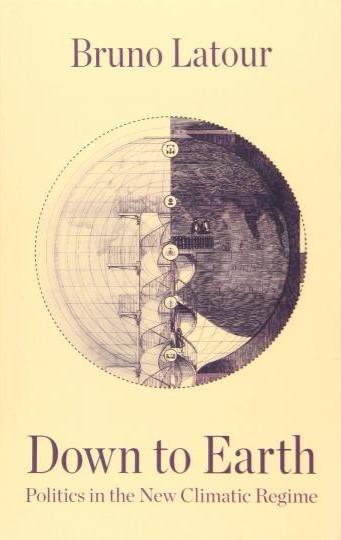
Down to Earth Politics in the New Climate Regime Bruno Latour, 2018
CONTEXT
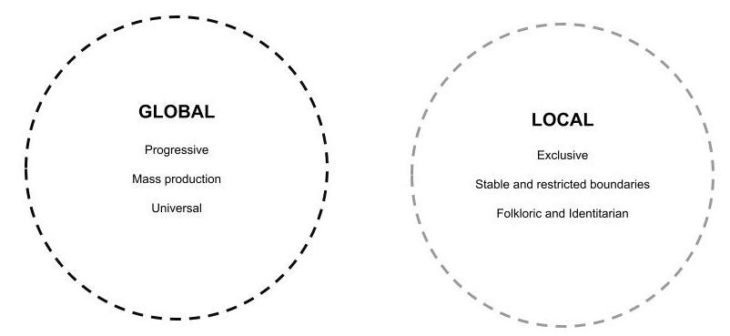
Both directions are problematic regarding a hospitable accommodation of humanity in the near future The reasons for this are that the local is too identarian and thus exclusive, whereas the global is too broad and homogenizing.


Figure 1:The globalness and the locality of architecture
RESEARCH QUESTION
How could a an architectural project re-originate Latour’s notion of the Terrestrial?
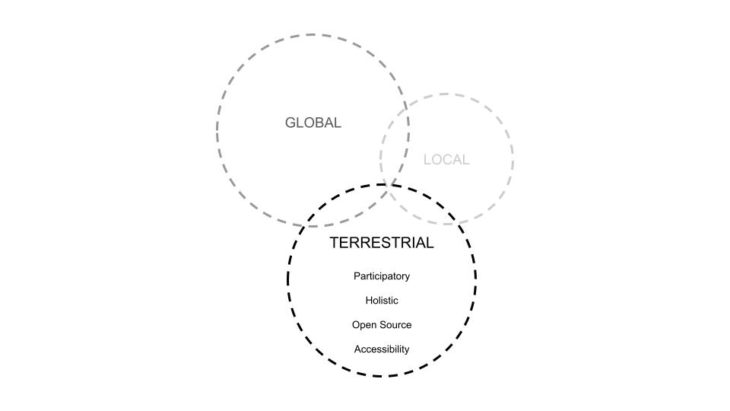
New Climate Regime
The term we define as Terrestrial includes new approach towards novel methodologies, which overcomes the opposition Global / Local. It also allows Architecture field to adapt novel technologies with the concept of open source data.
First all, it is necessary to justify the relevance that attracted the concern of us the architects over this issue. The dichotomy of the capitalized Global and the Local, as defined by Latour, are referring to the alienated explanation of their meanings as each of the groups are exercising the negative, limiting aspect of the respective term. On the other hand, architecture, as the external body that humans constructed to shelter ourselves from the elements, has also been divided into similar global and local categories in the past century.
The modern style of architecture, developed back in the early 20th century, was one of the most visible signals of globalization. Their clear-cut surfaces and the open floor structure celebrate the new methods of mass construction with a degree of elegance without obvious signs of the classical ornaments, and become the universal symbol of modernity regardless of their local context. The localness of architecture, on the other hand, has evolved for a much longer period of time. Drawn out of the age-old experiences with the regional biosphere and climate, architecture local to a specific civilization prior to the industrial age are always the product of human wisdom that finds mediation between the temper of their surrounding elements and their own demands of prosperity. Both of the two celebrated sides of architecture can be seen as what Latour has described as the “localization-plus” and “globalization-plus”, not yet deteriorated by the exclusive rigidity of the Global or the awkwardly reinvented definitions of Local traditions.
However, as the concept of both the locality and the global-ness are being displaced from their original meaning, architecture also cannot pretend to remain innocent, and will have to actively seek to represent a new politic, just like it did for the introduction of modernity. In order to achieve a solution to the principal issue addressed in Latour’s book, which is the conflict between our current method of development and the backfire of the Earth’s own agency, taking the form of ecological disasters, we will have to find a new way to build our homes. But are there any alternatives to build mass housing for the already overloaded and still increasing population of humans on Earth, other than the traditional method of one-way resources extraction and distribution?
HISTORICAL TRAJECTORY
The potential for Fab Lab’s system of making to contribute in the formation of Terrestrial living is actually not entirely speculative, for there has been practical precedence of similar concept. Michael Reynolds’ earthship biotecture series is a rather important example in pushing this argument, mainly because it is also a project that encourages individuals to build their own homes based on shared blueprints. Largely incorporating mud and waste materials such as tires and bottles and supplied with solar panels, these biotecture homes are designed to have their own thermal characteristics that relieved themselves from the infrastructural requirements of heating and cooling. If Fab Lab’s system of globally collective making based on local inventions can be combined with the evolution of the biotecture that recycles waste materials universal to modern society, then it could very well be a baby step towards real Terrestrial architecture.
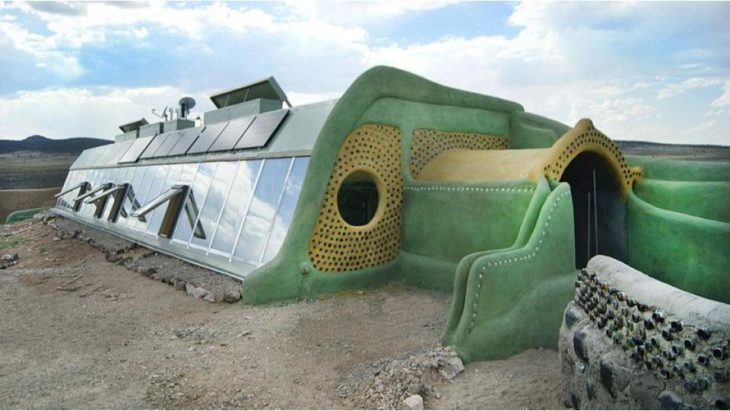
Figure 2:An earthship biotecture
Although being ecological and self-sufficient are indeed keys towards achieving Latour’s sense of being Terrestrial, it is still the ability to respect all involved living and nonliving actors that operates beside our bodies that renders it an unique concept in our innovation-driven age. This naturally means that the initiative of individuals is not enough.
HYPOTHESIS
The notion of Fab-City constitutes an appropriate system of architectural construction regarding the notion of Terrestrial.
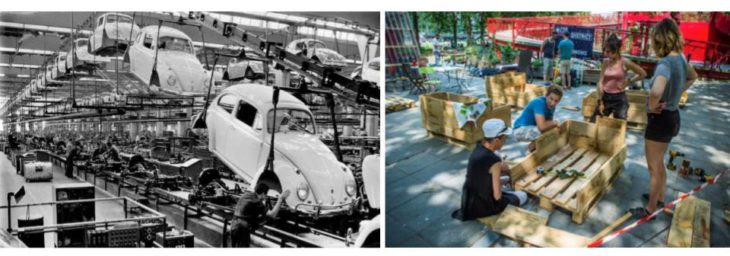
Figure 3:The production of Fordism and the making of Fab Lab
The Fab Lab system has offered a possible answer to this question, at least to its latter half. The present method of production in question is a system defined in the early days of the previous century, the mass production of Fordism. What Fordism means is pretty much in line with Latour’s globalization-minus: large companies dominating the mass production of certain commodities that people consume, and they achieves hegemony in supplying the said commodity by the sheer scale of their production, supported by even larger scale of resource extraction, resulting in the people’s irreplaceable reliance on the company’s mass production to obtain the involved products. The century-old system was challenged as early as 1988, though, by the identification of a new condition termed Post-Fordism: as production is being increasingly aided by automated technologies, namely the computers, the reliance on the violent fist of the central firm to organize labor and material resources has decreased, meaning that the capacity of the numerous relatively small-scale production plants are achieving the possibility of decentralizing the dominance of mass production of large firms while still satisfying the necessity of their proximate population. It is proposed that the Fab Lab’s creative system, emerged in the more recent days, might be capable of further deconstructing the centrality of production, and achieving a real sense of Terrestrial living.
STATE OF THE ART
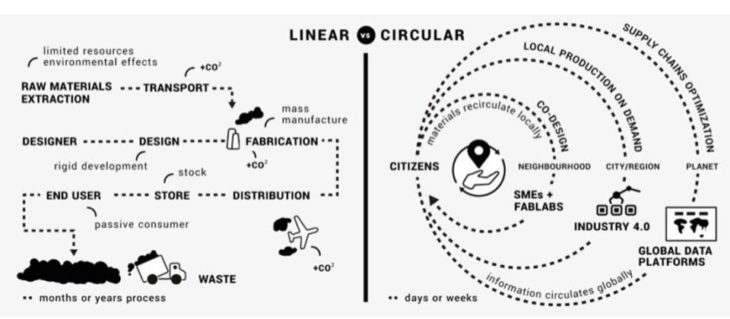
Figure 4:Distributed Design Approach
A new approach to design which utilises global connectivity to move data, instead of products. This ideology destroys the illusion of dependency created by the system of production and paves the way for humanity towards a system of engendering.

Figure 5:Fablab Open Source
What Fab Lab decentralizes is not just the scale and tools of labor, but the very concept of mass production. Fab Labs function almost like a public library, where citizens can access advanced digital-controlled fabrication tools to invent their own creations freely. With more than 1800 labs located in more than 100 countries, the Fab Lab system does not only allow local citizens to make what is suited for their need on their own, but also allows each of their individual inventions to be shared among all other laboratories through their open network. The widespread use of Fab Lab in the past decade was also itself a manifestation of alternative approach towards invention and production at the age of drastic social-technological advancements coupled with economic and ecological crisis, as the labs’ activities increased especially since the years of economic recession in Europe.
CASE STUDY
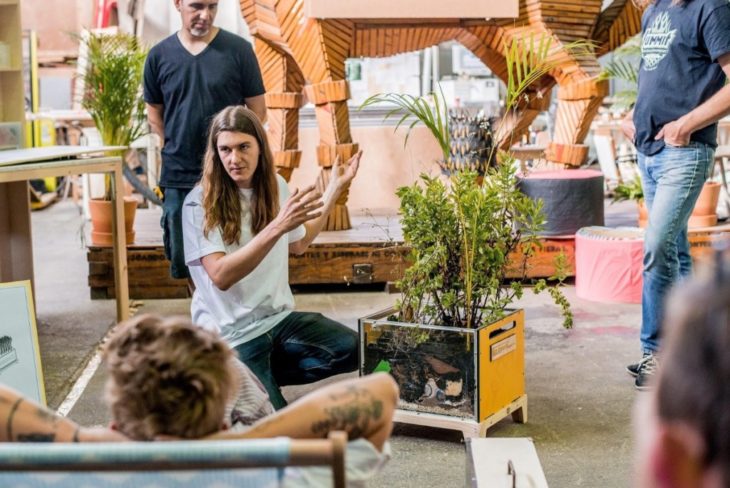
Figure 6:PARTICIPATORY
Engaging with all stakeholders in decision-making processes and empower citizens to take ownership of innovation and change-making.
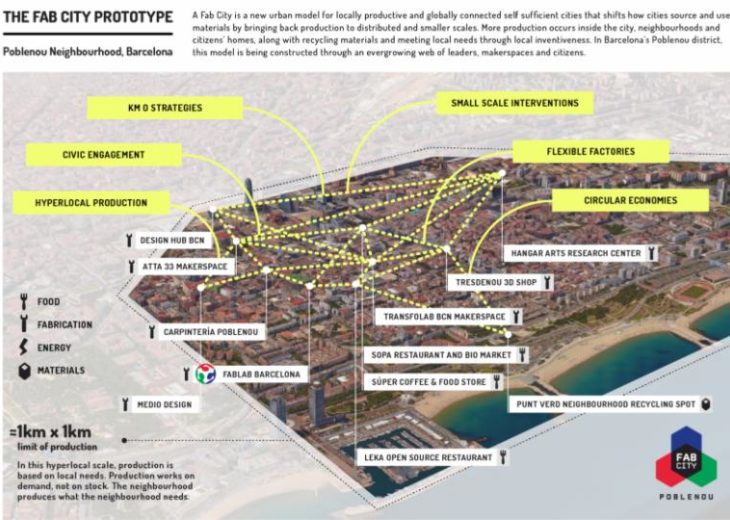
Figure 7:HOLISTIC
Addressing urban issues in all their dimension and interdependencies to build sustainable, resilient and inclusive cities for everyone.
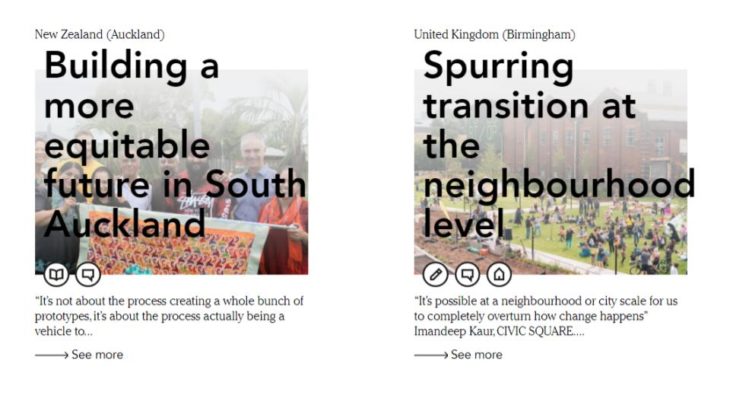
Figure 8:OPEN SOURCE
Digital Commons Approach that adheres to open source principles and values open data, in order to stimulate innovation and develop shared solutions between cities.
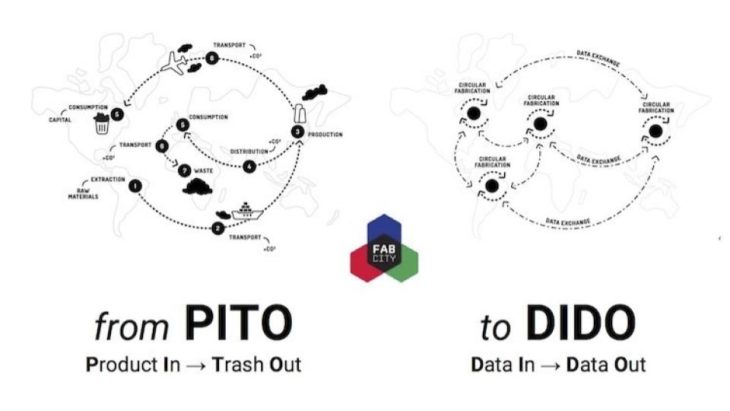
Figure 9:GLOCALISM
The efficient and shared use of all local available resources in a circular economy approach, to build a productive and vibrant city.
Although being ecological and self-sufficient are indeed keys towards achieving Latour’s sense of being Terrestrial, it is still the ability to respect all involved living and nonliving actors that operates beside our bodies that renders it an unique concept in our innovation-driven age. This naturally means that the initiative of individuals is not enough. The Fab Lab’s Fab-City initiative is another step further towards the Terrestrial. Guided by Fab Lab’s method of making, the Fab-City initiative is backed by the city council of Barcelona as a pledge for the world’s cities to discover ways of making everything they consume on their own. The result would be a living urbanity with its internal elements function like organs, interrelatable on all aspects and cycles on an healthy self-sustaining system in all levels, from energy to business alike. More importantly, it will be a system not designed by a single planner or a small circle of elites like the age-old technocracy, but will instead be co-designed with the participation of all citizens of a locality.
PERSPECTIVES
Once such Fab-Cities are achieved, their network can evolve further as their regional boundaries collide, becoming what will be called Fab-Territory.
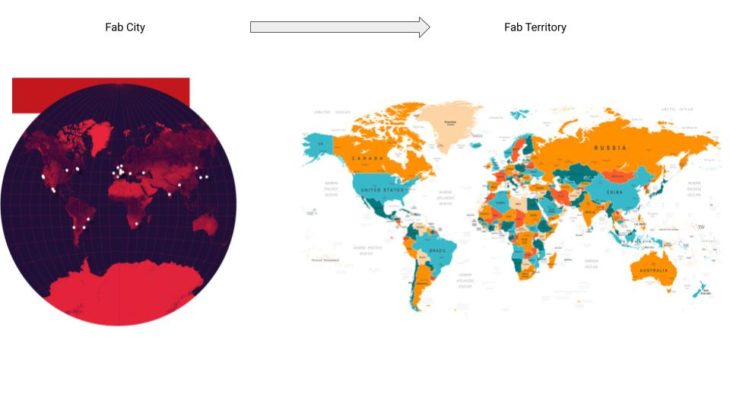
Figure 10:Fab Territory
Fab-City as a Terrestrial Device Beyond the Local/Global Dichotomy is a project of IAAC, the Institute for Advanced Architecture of Catalonia, developed during the Master in Advanced Architecture (MAA01) 2020/21 by students: Changkai Qi, Enlin Guo, Pragati Patilkulkarni, Sarjak Rakholiya, Taimur Mian, Vishakha Pathak; faculty: Manuel Gausa, Jordi Vivaldi.
Source of Figures
Figure 1: Latour, Down to Earth, 109.
Figure 2: Reynolds, “Earthship Design Principles.”
Figure 3: Fab City Global Initiative, “Our Approach.”
Figure 4: Tomas Diez, “Fab City Prototypes — Designing and making for the real world,” Fab
City Blog, July 3, 2017.
Figure 5,6,7,8,9 & 10: Fab City Global Initiative, “Our Approach.”
Unlisted Images are from the public domain.
BIBLIOGRAPHY
Latour, Bruno. Down to Earth. Cambridge: Polity Press, 2018.
yorku.ca. “What is Fordism?” Fordism. Accessed November 20, 2021.
Thomas, Martin. “‘Post-Fordism’: collapsing into the present.” Workers’ Liberty, October 15, 2005
Kohtala, Cindy. “Making ‘Making’ Critical: How Sustainability is Constituted in Fab Lab Ideology.”
The Design Journal 20, Issue 3 (2017), 375-394, DOI:10.1080/14606925.2016.1261504
Fab Lab Barcelona. “About Fab Lab Barcelona.” Accessed November 20, 2021.
Ramella, Francesco, and Cecilia Manzo. “Into the crisis: Fab Labs – a European story.” The
Sociological Review Monographs 66, No. 2 (2018), 341-364. doi:10.1177/0038026118758535.
Reynolds, Michael. “Earthship Design Principles.” Earthship Biotecture. Accessed November 20, 2021.
Fab City Global Initiative. “Our Approach.” Accessed November 20, 2021.